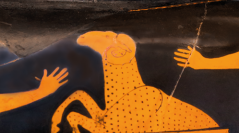

 Anthropozoologica
59 (4) - Pages 37-52
Anthropozoologica
59 (4) - Pages 37-52The De arte venandi cum avibus, a large treatise on falconry in six books, written by emperor Frederick II of Hohenstaufen in the years 1230, comprises a thorough ornithological inquiry in its first book, with a wealth of precise descriptions. The case of the waterbirds, treated in large diversity and detail by the author, provides abundant clues of his precise observations, as he treats with equal intensity their external characteristics as well as their anatomy, which presupposes their dissection. His observations leads in some cases to experiments, as is shown here by quotations about the vulture, the cuckoo and the barnacle goose. The treatises on falconry of Frederick II, which is quite different from the mainstream of medieval natural history, hence deserves a major place in the history of ornithology.
Falconry, ornithology, Middle Ages.